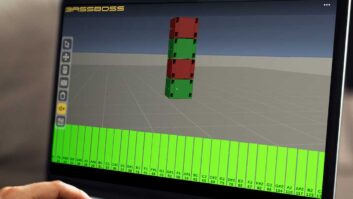I am not the first person to write about tape restoration; Phil De Lancie documented his treatment for “sticky shed” way back in May 1991. In a previous life, I built a hair-dryer-powered Easybake oven with great success, and while other folks have been using convection ovens since, I’ve found an equally clever solution. Would you believe a food dehydrator? Perfectly suited to the task, its round shape matches the incoming wounded, the temperature range is appropriate (and completely safe), and it’s more affordable. Plus, it makes jerky and “sun-dried” tomatoes on the side!
THE OLD TAPE’S HOME
The aging of magnetic tape affects every tape-based recording medium; not just old analog recordings, but digital, data and video, as well. Since the late 1960s, certain tape formulations have been prone to shedding, a problem that is, in part, due to chemical inconsistencies beyond the control of tape manufacturers. The problem is especially acute for mid-’70s-era, high-output tapes, such as Ampex 406/407/456, 3M 250 and AGFA 468. Some tapes of more recent vintage also have shedding problems.
Tapes should be stored in a cool, dry environment between 50° F and 70° F, 20% to 45% relative humidity. Lower numbers are better for longer-term storage. Recorded media should be treated as if destined to become an essential part of history. Most recorded tape has received only average treatment early in its history when it is still being regularly accessed and handled, and perfect conditions are hard to achieve unless measures that make the recordings difficult to access are taken. By the time a tape reaches “proper” storage, the damage has already started.
You may have noticed that new tapes are often sealed in plastic, which protects them from the environment until they are ready for use. Too bad it’s not resealable. This article will show how to treat the ailing patients, then apply Egyptian-style preservation techniques to maximize their usefulness in the Afterlife (cue: Bell Tree).
INGREDIENTS
Recording tape consists of four primary elements: the plastic carrier (mylar/polyester), the magnetic oxide (rust for storage, yeah!), an optional conductive back treatment (carbon impregnation improves “winding” performance while reducing static), plus the binder (the glue that holds it all together).
The combination of time, extreme conditions and/or chemical instability can make tapes unplayable to the point where they can’t even be rewound. The culprit is binder hydration, the gradual absorption of moisture that turns this special “glue” into the consistency of molasses. Dehydration reactivates the binder. To keep it that way, reseal the tape in plastic to keep moisture out, adding a silica gel pack to absorb any moisture trapped in the bag.
WHO R U?
A tape in an unlabeled white box on a hub provides little clue as to its type, age or recorded direction. European tapes are the exception, because make and type are often printed on the back coating. Prehistoric acetate does not require baking, so it’s important to learn how to distinguish it from mylar/polyester. Repeat: Do not bake acetate! Hold a reel of tape up to a light as in Fig. 1; acetate is translucent, and polyester is opaque. Acetate was primarily used from the ’50s until the ’60s; it never stretched, breaks clean and can be quite brittle now.
Vintage tapes like Scotch 111 have an orange-ish oxide, whereas later tapes like Scotch 201 have black oxides. Other oxide color variations can range from red to brown. Mylar/polyester eventually replaced acetate. It handles stress well, can be stretched to a string before breaking and makes nifty apparel when recycled. 1960s-era mylar tapes with black oxide and no back coating will be the least problematic.
DO BEE AND DON’T BEE
People who make analog recording part of their daily routine take for granted that the tape is new and that the machine is in a happy state. When called to remaster, remix or restore a vintage recording, the machine must be in top form and your business should be insured. Tape condition is the one variable that can’t be predicted. You really don’t want to discover a problematic tape during fast wind. Repeat: Do not fast-wind vintage tapes before first determining condition. In order to reduce the risk of damage, the safest approach is to play the tape in whatever direction needed, but don’t play anything yet.
SLOW RIDE
In order to be baked, a tape must have a smooth, even “wind.” The right-most image in Fig. 1 is anything but. Tapes stored in a carelessly wound state absorb more moisture, and if they are baked that way, then they will have severe edge deterioration. Tapes stored in the played state are said to be “tail out,” minimizing any print-through between layers, or at least masking it as “post-echo.” (Pre-echo is the annoying alternative.) If the pack is good and the tape is known to be tail out, a conservative first pass in the dehydrator is possibly unnecessary, but it’s better than wasting time repacking a gooey tape. Properly stored tapes may still deteriorate but recover well with treatment.
Once you are ready to repack a tape, it is best to remove the head assembly to minimize the number of contact surfaces. The goals are to preserve the oxide and minimize the clean-up. Every stationary surface — head, guide or lifter — will scrape oxide off the tape. Although in most cases, this will only be a little bit scary, stopping the tape will deposit clumps of oxide that are hard to remove and will ultimately become baked into the tape.
The best machines for slow-winding traumatized tapes are those with all-rotating guides. The Ampex ATR-100 is almost perfect, because it has two stationary lifters that can be avoided if the headstack is removed. Studer machines are also well-suited for slow winding, because all guides rotate. Model 800 Series Studer machines are dangerously powerful, so it is worth repeating: Do not fast-wind questionable tapes. Don’t use the remote, stand by the machine at all times, pay close attention and be ready to stop at a moment’s notice. Play tensions are lower than wind tensions; some machines have “small-reel” settings that further reduce tension.
If the headstack can’t be removed, or if there are stationary guides that can’t be avoided, then cover them with a cloth or a paper towel to soften the hard edges, collect the oxide and minimize cleanup. If possible, figure out a way to slide or rotate the cloth to a clean section while the tape is rolling. Be prepared for splices to fail before and after baking. Once the tape is at the head, “play” the tape one more time so that its “tail” is out and the pack is smooth. I know this is an excruciating amount of detail, but it’s better to know the issues in preparation for that one truly funky tape than to find the oxide stuck to the wrong side of the plastic — it has happened to me.
HUB BUB
Tapes on plastic reels with small hubs should be rewound onto large reels with NAB hubs. Be careful to thread the tape around the hub without any creases. There should be about five minutes’ worth of pad at the head of the tape; add if necessary. The goal is to minimize mechanical distortions that can be impressed upon subsequent layers, especially after baking, causing dropouts. When baked, the tape will expand and become loose around the hub. For this reason, use reels with flanges to protect the tape from coming unwound in a way that is scarier than any Stephen King or Anne Rice novel.
NOTHIN’ SAYS LOVIN’ LIKE SOMETHIN’ FROM THE OVEN
The device du jour is the Snackmaster Pro model FD-50 made by American Harvest (800/288-4545; www.americanharvest.com). At $90 with shipping, it comes standard with four trays, each of which can comfortably handle a reel of half-inch tape. (Additional trays and jerky mixes can be ordered. Shipping is generally fast, but allow up to four weeks for delivery in case Mix readers deluge their ordering system.) To accommodate 1- and 2-inch tapes, modify one tray by cutting out the plastic spokes along the perimeter with a wire cutter. This creates a “dummy tray,” adding height to the tray below.
The FD-50 features an adjustable thermostat and a built-in fan to circulate the air. I checked for magnetic fields and found none, though I do use the upper trays just to be safe. (The fan is in the bottom of the unit.) The heat is adjustable from 95° F to 145° F and is accurate within 5° when checked with a photographic thermometer.
DON’T SHAKE, BAKE!
I bake quarter-inch tapes on 10-inch reels at 135° F for two hours, flipping every half-hour. You’ll find that cooking time varies with tape width, type, brand, condition, and the size and number of reels being baked. Ampex tape from the ’70s might require twice as much time as 3M tape from the ’80s (as reported by Wendy Carlos when restoring her masters from that time period). The table below can be used as a guide.
I am conservative about baking time and temperature, not for fear of losing high frequencies, but to be safe and slow; hence, the wide range. It is best to start with noncritical tapes. For example, I have baked funky test tapes — without degrading the tones — to show that the process works. The alternative — heads clogging with gooey gunk every minute during transfer — is worse.
After baking the tape, return it to its box and let it cool for the same amount of time as it was baked. Include a silica gel pack if possible. To confirm that the process was successful, put cloth across the head assembly and play the tape backward for five to 10 minutes. Stop and observe. Shed should be minimal. For noncritical tapes, I’ve sandwiched a piece of cloth around the tape and held the cloth between two fingers while the tape was rewinding. A minimal a-mount of oxide shed is normal, but Fig. 3 shows what happens before baking. If the tape still sheds after treatment, put it back in! Based on my experience, tapes can be baked more than once.
POST-RESTORATION STORAGE
Wrapping tape in a plastic bag and including a silica gel pack to absorb moisture is one way to preserve baked tapes. Silica gel can adsorb up to 40% of its weight in moisture — 40 grams protects three cubic feet — and it can be baked to reactivate! Silica gel packs are available from www.foodsave.net (follow the Magnetic Media Preservation Area link), as well as from photo stores such as www.keh.com. And, if you really want to preserve like an Egyptian, a 12-inch plastic-sealing tool (model TEW H-300C) is available at www.hillas.com for $80. All you need is the appropriate-sized bag.
IT’S A CLEAN MACHINE, VERY CLEAN
Once it is baked, the tape should play like new, but worn heads will aggravate the process of getting a good transfer from new or old media. Figure 4 shows multiple views of a 2-track head. At the bottom, the lighting conveniently darkened the wear pattern of the worn head, making it appear as a horizontal bar across the center. Just above, arrows point to where oxide gets trapped in the groove worn by the tape. Use a toothpick or a business card to remove stubborn dirt, along with your head cleaner of choice.
Worn heads like this one should be relapped to improve high-frequency response and reduce low-frequency muddiness. To prevent a future groove from trapping dirt and degrading performance, “relief slots” can be cut into the surface as indicated in the top image of Fig. 4. John French at JRF Magnetic Sciences (973/579-5773; www.jrfmagnetics.com) restores and sells tape heads, and he carries test tapes, demagnetizers, reel hubs and other related accessories.
While I’m on the subject, if your demagnetizer has a switch, it can do more harm than good. Defeat the switch or throw it away and buy an Annis Han-D-Mag (www.maginst.com). That’s all for July. Have a great summer, and keep humidity in your facility below 45%.
Eddie never got around to posting pics of number two son, Justin Marcello, but Polly did.






